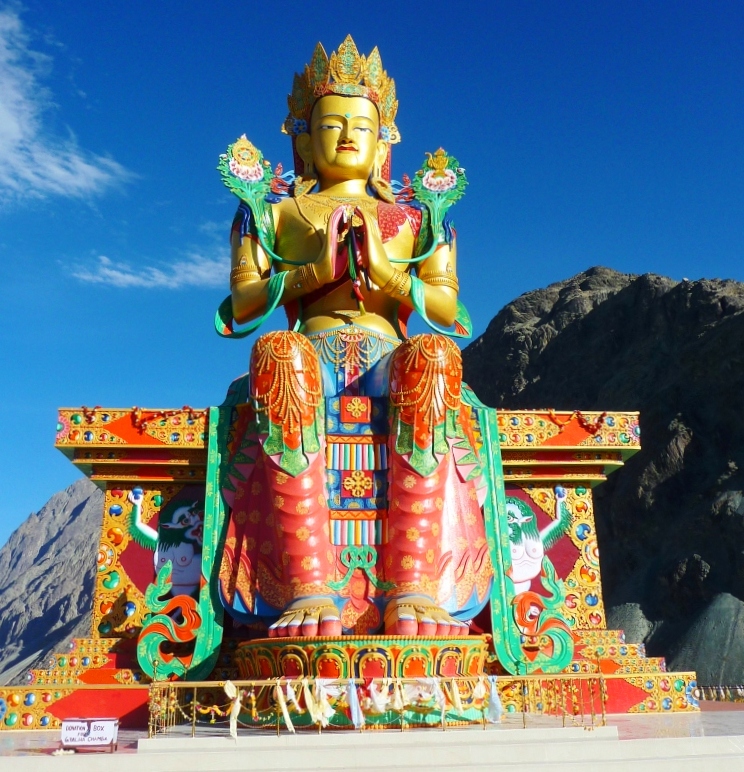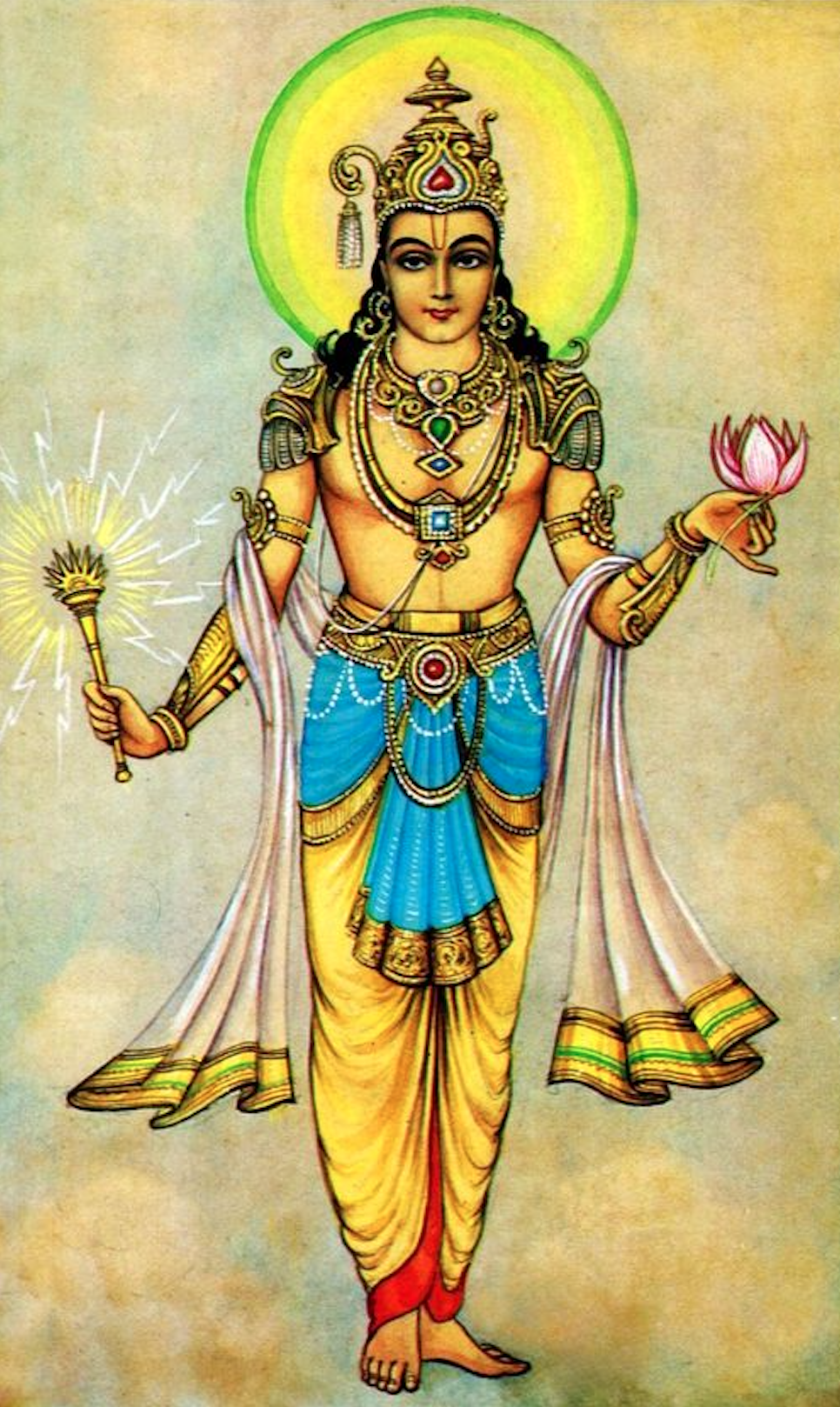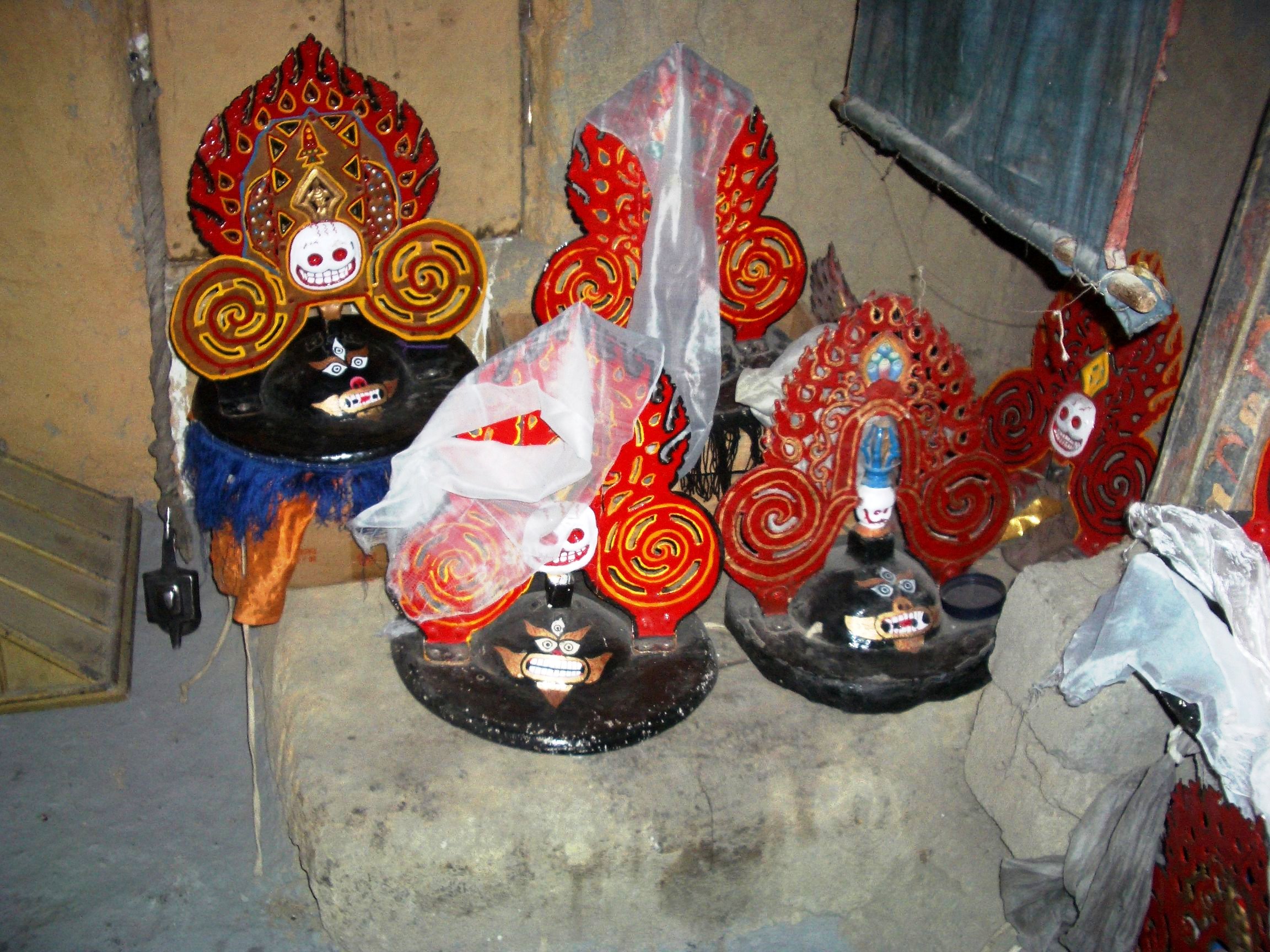|
Thikse Monastery
Thikse Gompa or Thikse Monastery (also transliterated from Ladakhi as Tiksey, Thiksey or Thiksay) is a gompa (Tibetan-style monastery) affiliated with the Gelug sect of Tibetan Buddhism. It is located on top of a hill in Thiksey approximately east of Leh in Ladakh, India. It is noted for its resemblance to the Potala Palace in Lhasa, Tibet, and is the largest gompa in central Ladakh, notably containing a separate set of buildings for female renunciates that has been the source of significant recent building and reorganisation. The monastery is located at an altitude of in the Indus Valley. It is a twelve-storey complex and houses many items of Buddhist art such as stupas, statues, thangkas, wall paintings and swords. One of the main points of interest is the Maitreya Temple installed to commemorate the visit of the 14th Dalai Lama to this monastery in 1970; it contains a high statue of Maitreya, the largest such statue in Ladakh, covering two stories of the building. Histor ... [...More Info...] [...Related Items...] OR: [Wikipedia] [Google] [Baidu] |
Thiksey
Thiksey is a village and the headquarter of its eponymous block in the Leh district of Ladakh, India. It is located in the Leh tehsil. The Thikse Monastery Thikse Gompa or Thikse Monastery (also transliterated from Ladakhi as Tiksey, Thiksey or Thiksay) is a gompa (Tibetan-style monastery) affiliated with the Gelug sect of Tibetan Buddhism. It is located on top of a hill in Thiksey approximately ... is located here. Demographics According to the 2011 census of India, Thiksey has 433 households. The effective literacy rate (i.e. the literacy rate of population excluding children aged 6 and below) is 75.42%. References {{Leh district Villages in Leh tehsil ... [...More Info...] [...Related Items...] OR: [Wikipedia] [Google] [Baidu] |
Saṃbhogakāya
''Saṃbhogakāya'' ( sa, संभोगकाय lit. "body of enjoyment", zh, t=報身, p=bàoshēn, Tib: ''longs spyod rdzog pa'i sku'') is the second mode or aspect of the Trikaya. Definition Celestial manifestations ''Sambhogakāya'' is a "subtle body of limitless form". Buddhas such as Bhaisajyaguru and Amitābha, as well as advanced bodhisattvas such as Avalokiteśvara and Manjusri can appear in an "enjoyment-body." A Buddha can appear in an "enjoyment-body" to teach bodhisattvas through visionary experiences. Those Buddhas and Bodhisattvas manifest themselves in their specific pure lands. These worlds are created for the benefits of others. In those lands it is easy to hear and practice the Dharma. A person can be reborn in such a pure land by "the transfer of some of the huge stock of 'merit' of a Land's presiding Buddha, stimulated by devout prayer." One of the places where the ''Sambhogakāya'' appears is the extra-cosmic realm or pure land called Akaniṣṭha. T ... [...More Info...] [...Related Items...] OR: [Wikipedia] [Google] [Baidu] |
Stok Monastery
Stok Monastery or Stok Gompa is a Buddhist monastery in Stok, Leh district, Ladakh, northern India, 15 kilometres south of Leh. It was founded by Lama Lhawang Lotus in the 14th Century and has a notable library including all 108 volumes of the Kangyur. A ritual dance-mask festival is held annually. Next to the monastery is the 71 feet (22 m) high seated Gautama Buddha statue and temple, constructed between 2012-2015 and consecrated by the 14th Dalai Lama on 8 August 2016. Around 2 km from the monastery is Stok Palace, built in 1820 as the summer home of Ladakhi royalty from the Namgyal dynasty of Ladakh. Gallery File:Stok palau 2.jpg File:Stok palau 3.jpg File:Stok palau 4.jpg See also * Chogyal The Chogyal ("Dharma Kings", ) were the monarchs of the former Kingdom of Sikkim, which belonged to the Namgyal dynasty. The Chogyal was the absolute monarch of Sikkim from 1642 to 1975, when the monarchy was abolished and the Sikkimese peo ... References {{Buddhi ... [...More Info...] [...Related Items...] OR: [Wikipedia] [Google] [Baidu] |
Diskit Monastery
Diskit Monastery also known as Deskit Gompa or Diskit Gompa is the oldest and largest Buddhist monastery (gompa) in Diskit, in the Nubra Valley in the Leh district of Ladakh, India. It belongs to the Gelugpa (Yellow Hat) sect of Tibetan Buddhism. It was founded by Changzem Tserab Zangpo, a disciple of Tsong Khapa, founder of Gelugpa, in the 14th century. It is a sub-gompa of the Thikse gompa. Lachung Temple and Hundur Monastery are also located nearby, the latter is below the main road near a bridge. The monastery has statue of Cho Rinpoche (Crowned Buddha) in the prayer hall, a huge drum and several images of fierce guardian deities. An elevated cupola of the monastery depicts a fresco of the Tashilhunpo Monastery of Tibet. The monastery administration runs a school, with support from a non-government organization known as the "Tibet Support Group", which has computer facilities and teaches science subjects, in English, to Tibetan children of the region. A popular festiva ... [...More Info...] [...Related Items...] OR: [Wikipedia] [Google] [Baidu] |
Hemis Monastery
Hemis Monastery is a Himalayan Buddhist monastery (''gompa'') of the Drukpa Kagyu, Drukpa Lineage, in Hemis, Ladakh, India. Situated 45 km from Leh, it was re-established in 1672 by the Ladakhi king Sengge Namgyal. The annual Hemis festival honouring Padmasambhava is held there in early June. Hemis village is located 40 km southeast of Leh on Leh-Manali Highway and under-construction Bilaspur–Leh line. History Hemis Monastery existed before the 11th century. In 1894 Russian journalist Nicolas Notovitch claimed Hemis as the origin of an otherwise unknown gospel, the ''Life of Saint Issa, Best of the Sons of Men,'' in which Jesus is said to have travelled to India during his 'Unknown years of Jesus, lost years'. According to Notovitch, the work had been preserved in the Hemis library and was shown to him by the monks there while he was recuperating from a broken leg. But once his story had been re-examined by historians, it is claimed that Notovitch confessed to hav ... [...More Info...] [...Related Items...] OR: [Wikipedia] [Google] [Baidu] |
Vajra
The Vajra () is a legendary and ritual weapon, symbolising the properties of a diamond (indestructibility) and a thunderbolt (irresistible force). The vajra is a type of club with a ribbed spherical head. The ribs may meet in a ball-shaped top, or they may be separate and end in sharp points with which to stab. The vajra is the weapon of Indra, the Vedic king of the devas and heaven. It is used symbolically by the dharmic traditions of Hinduism, Buddhism, and Jainism, often to represent firmness of spirit and spiritual power. According to Hinduism, the vajra is considered one of the most powerful weapons in the universe. The use of the vajra as a symbolic and ritual tool spread from Hinduism to other religions in India and other parts of Asia. Etymology According to Asko Parpola, the Sanskrit () and Avestan both refer to a weapon of the Godhead, and are possibly from the Proto-Indo-European root ''*weg'-'' which means "to be(come) powerful". It is related to Proto ... [...More Info...] [...Related Items...] OR: [Wikipedia] [Google] [Baidu] |
Rinchen Zangpo
__NOTOC__ Lochen Rinchen Zangpo (958–1055; ), also known as Mahaguru, was a principal lotsawa or translator of Sanskrit Buddhist texts into Tibetan during the second diffusion of Buddhism in Tibet, variously called the New Translation School, New Mantra School or New Tantra Tradition School. He was a student of the famous Indian master, Atisha. His associates included (Locheng) Legpai Sherab. Zangpo's disciple Guge Kyithangpa Yeshepal wrote Zangpo's biography.Roberto Vitali, in McKay 2003, pp. 71-72 He is said to have built over one hundred monasteries in Western Tibet, including the famous Tabo Monastery in Spiti, Himachal Pradesh, Poo in Kinnaur and Rinchenling monastery in Nepal. Rinchen Zangpo had been sent as a young man by King Yeshe-Ö, the ruler of Zanskar, Guge, Spiti and Kinnaur, with other young scholars to Kashmir and other Buddhist centres to study and bring back Buddhist teachings to Western Tibet. He was possibly the single most important person for t ... [...More Info...] [...Related Items...] OR: [Wikipedia] [Google] [Baidu] |
Kadam (Tibetan Buddhism)
300px, Tibetan Portrait of Atiśa The Kadam school () of Tibetan Buddhism was an 11th century Buddhist tradition founded by the great Bengali master Atiśa (982-1054) and his students like Dromtön (1005–1064), a Tibetan Buddhist lay master.Silk, Jonathan A; von Hinüber, Oskar; Eltschinger, Vincent; Bowring, Richard; Radich, Michael (2015). ''Brill's Encyclopedia of Buddhism: Vol. II Lives'', pp. 1145-1158. Brill. The Kadampa stressed compassion, pure discipline and study.Chokyi Dragpa (2015). ''Illuminating the Thirty-Seven Practices of a Bodhisattva'', Glossary. Simon and Schuster. The most evident teachings of that tradition were the graduated teachings on the Mahayana path. These special presentations became known as lojong (mind training) and lamrim (stages of the path). Kadam masters like Atiśa also promoted the study of madhyamaka philosophy. According to Ronald M. Davidson, "Atiśa's coming to Tibet in 1042 was the threshold moment in the efflorescence of Buddhi ... [...More Info...] [...Related Items...] OR: [Wikipedia] [Google] [Baidu] |
Torma
Torma (Skt: Balingta, Tib: Tor-ma, Wylie: gtor ma) are figures made mostly of flour and butter used in tantric rituals or as offerings in Tibetan Buddhism. They may be dyed in different colors, often with white or red for the main body of the torma. They are made in specific shapes based on their purpose, usually conical in form. A very large, central shrine torma may be constructed for festivals, though typically they are small and placed directly on a shrine, on a plate, mounted on leather or held on a special base like a skull. History The tradition of using offering cakes pre-dates Tibetan Buddhism, though traditional Indian offering cakes — called ''bali''Kongtrul (1998) p. 129 or ''balingha''Kongtrul (1998) p. 199 in Sanskrit Sanskrit (; attributively , ; nominalization, nominally , , ) is a classical language belonging to the Indo-Aryan languages, Indo-Aryan branch of the Indo-European languages. It arose in South Asia after its predecessor languages had ... [...More Info...] [...Related Items...] OR: [Wikipedia] [Google] [Baidu] |
Likir Monastery
Likir Monastery or Likir Gompa (Klud-kyil) is a Buddhist monastery in Ladakh, Northern India. It is located at 3700m elevation, approximately in the west of Leh. It is picturesquely situated on a little hill in the valley, in Likir village near the Indus River about north of the Srinigar to Leh highway. It belongs to the Gelugpa sect of Tibetan Buddhism and was established in 1065 by Lama Duwang Chosje, under the command of the fifth king of Ladakh, Lhachen Gyalpo (Lha-chen-rgyal-po). Although Likir is relatively isolated, it was once on a major trade route which travelled via Tingmosgang, Hemis and Likir to Leh. History Likir is mentioned in the Ladakhi chronicles as having been erected by King Lhachen Gyalpo (Lha-chen-rgyal-po) (c. 1050-1080 CE).Francke (1914), p. 87. It presumably, originally belonged to the early Kadampa order of Tibetan Buddhism. When Francke visited the monastery in 1909 he was shown a long inscription written in black ink on a wall which outline ... [...More Info...] [...Related Items...] OR: [Wikipedia] [Google] [Baidu] |
Spituk Monastery
Spituk Monastery, also known as Spituk Gompa or Pethup Gompa, is a Buddhist monastery in Spituk, Leh district, Ladakh, northern India. 8 kilometres from Leh. The site of Spituk was blessed by the Arhat Nyimagung. It was founded by Od-de, the elder brother of Lha Lama Changchub Od when he came to Maryul in the 11th Century. He introduced the monastic community. When Lotsewa Rinchen Zangpo (Translator) came to that place he said that an exemplary religious community would arise there and so the monastery was called spituk (exemplary). During the time of Dharma raja Gragspa Bum-Ide the monastery was restored by Lama Lhawang Lodos and the stainless order of Tsonkhapa was introduced and it has remained intact as such till present. Founded as a Red Hat institution, the monastery was taken over by the Gelugpa (Yellow Hat sect) in the 15th century. The monastery contains 100 monks and a giant statue of Kali (unveiled during the annual festival). Every year the Gustor Festival is held at ... [...More Info...] [...Related Items...] OR: [Wikipedia] [Google] [Baidu] |


.jpg)





